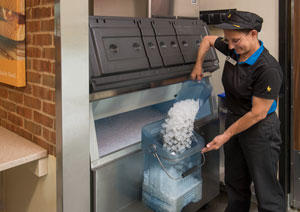
Whatever they’re called—nuggets, Pearls, Chewblets, chunklets, cubelets, or the Original Chewable ice—compressed flake ice nuggets have grown increasingly popular in foodservice. First becoming a staple in stores in the south and southeast where the weather is warmer throughout the year, nugget ice became much better known as chains like Sonic expanded and introduced it to more people.
“Chewable ice has been the fastest growing type of ice for the past few years,” says one manufacturer. While cube ice is still preferred for most cocktails, nugget ice is “great for soft drinks and blended beverages,” the maker says.
To understand why customers like it so much, it helps to know how nugget ice differs from ice cubes. Cubers are batch ice makers, essentially like a large version of the ice tray or ice maker in your refrigerator’s freezer. Water flows over or into an evaporator shaped like a giant ice cube tray, freezes in layers until a cube forms, and the cubes are ejected to complete the cycle.
Nugget ice makers work continuously, freezing water on the inside of a cylindrical evaporator. A spiral auger continuously scrapes ice off the evaporator in little flakes and forces them forward toward a compression nozzle that squeezes the flakes together into a more solid form. As the compressed ice is pushed through the nozzle or extrusion head, a cutter or breaker head cuts the ice into nuggets (or whatever the manufacturer calls its particular sized and shaped compressed ice chunk).
The nuggets themselves are a combination of ice, water, and air as a result of the minute gaps between the compressed flakes. The design of the extrusion head largely determines how much water is squeezed out of the nugget as it’s being formed and how tightly the flakes are compressed. That means some types of nuggets are almost as hard as cubes, and others much softer—and more chewable.
Customers like compressed-flake ice because of that chewability, and because its nooks and crannies tend to “absorb” some of the beverage in which it’s used, making it “more like candy,” according to one manufacturer.
Save Water, Energy
You’ll like nugget ice because the machines that make it are more efficient than cubers, which can save you money. Water has minerals and other elements in it called total dissolved solids. Pure water freezes faster than water with a high mineral or TDS content.
When water cascades over an evaporator in a cube machine, pure water freezes first, letting the water with TDS content fall to a sump at the bottom of the machine. This water has an increasingly high concentration of TDS by the time the cubes are finished, and must be flushed out before starting a new freezing cycle.
Nugget ice machines continuously freeze water on the inside of a cylindrical evaporator where it’s scraped off by a rotating auger, so there’s no ice cube dump at the end of a cycle. Most excess water is squeezed out of the nuggets at the extrusion head, but the concentration of TDS in the excess is far less than that in a cuber, so there’s less need for flushing. Nugget machines typically use about 12 gal. or less water per 100 lb. of ice produced, about 35% less than cubers of equivalent size.
TDS in the water supply, though, can cause scale buildup on the inner parts of any ice machine, and the working parts of a nugget ice machine are more susceptible to wear and breakdown if scale isn’t kept in check. The first line of defense is good water filtration. No matter which model you buy, work with the manufacturer to ensure that you have the right filtration for water in each of your locations (see filtration article on pg. 65). Most machines have a periodic flush cycle to keep TDS to a minimum.
One maker has reduced the need for flushing even further through a uniquely clever design that also reduces or eliminates the need for descaling the machine. In the maker’s old models, water entered the freezing cylinder— which is horizontal—from the rear and was continuously pushed forward as the auger turned. Since pure water freezes faster than water containing TDS, water with increasingly higher concentrates of TDS was pushed forward causing more scale build-up in the front of the auger, at the nozzle and cutter head, impairing performance and potentially harming the machine if not descaled regularly.
In the newly designed models, water is introduced from the front of the cylinder, forcing TDS to the back as the auger turns, away from the cutter and compression nozzle. The high-TDS concentrated water eventually falls into a small sump at the back of the machine. Periodic low-volume water flushes clear the TDS-concentrated water from the sump.
Most nugget ice machines have a vertically mounted evaporator and auger with water entering from the bottom. As the auger moves water up the cylinder, gravity tends to pull TDS back down to the bottom, and the flush cycle clears the TDS from the units.
Nugget machines also save energy over cubers. After standardized test methods came about for nugget machines and they joined the Department of Energy’s list of equipment that can earn Energy Star qualification in 2013, nugget machines have generally proved about 15% more efficient than cubers of equal capacity.
How Big?
How much ice you need depends primarily on your operation’s beverage program in addition to other factors, including product cooling, display and product packaging. Several equipment makers have calculators on their websites to make it easier for you to estimate the size machine you need. Whatever daily production rate you calculate for your operation, it’s always a good idea to size your machine at the volume needed to handle peak demand. But some makers tell us operators also have a tendency to order much larger machines than they’ll really need, resulting in stale ice, ice caves in the bins and wasted water. So following manufacturers’ expert recommendations is smart.
As a general rule of thumb, a restaurant will use 1.5 lb. of ice per meal sold; a bar will use about 3 lb. per seat per day; hotels should count on 5 lb. per guest room; and healthcare operations should plan on 10 lb. per day per patient, and an additional pound per person served in the cafeteria.
Another key factor in determining size is where and how you plan to produce and dispense ice. Nugget ice makers, as with many cubers, are often modular units with an ice-making head that can be placed on a storage bin, an ice dispenser, an ice and water dispenser, or a beverage dispenser. The ice maker itself may be an air-cooled, self-contained unit, water-cooled or remote unit, giving you a lot of options over how you produce, distribute and dispense the ice you need for your operation.
Since an increasing number of customers prefer chewable ice, if you have self-serve beverage stations in your operation consider getting more capacity than you think you need. “A typical size for a machine in fast food these days has a 900- to 1,000-lb. capacity instead of a 600-lb. machine in the past,” one manufacturer says. “The increase is partly due to the Coke Freestyle machine.”
Sizes range from small countertop units to floor models that produce anywhere from 400 lb. per day to as much as 2,400 lb. per day.
Hard Or Soft?
One of the reasons nugget machines weren’t added to the DOE’s Energy Star program until ’13 is that no testing method had been developed for determining the hardness of nugget ice since compacted-flake ice also includes water and air. Once the Air-Conditioning, Heating and Refrigeration Institute got a handle on how to do that, third-party testing facilities such as Frontier Energy’s Food Service Technology Center, run by Fisher-Nickel at PG&E in San Ramon, Calif., could compare apples to apples.
The fact is, not all nuggets are created equal. Some are harder than others, almost as hard as cubes. If the benefit of nuggets is that they’re chewable, why would you want nuggets as hard as cubes? A couple of reasons, it turns out.
First of all, though they may be hard, nuggets still comprise compressed flakes and break apart more readily than solid cubes—in other words, they’re still chewable. Second, harder nuggets are more easily transported through a tube from remote locations. A couple of systems—RIDE (remote ice delivery equipment) and Ice Link—can move ice from a back-room ice maker to a bin on top of a beverage dispenser in the front of the house, keeping noise and heat out of that area. Finally, harder nuggets—like harder cubes—melt more slowly. While melt time is the result of a number of factors, such as surface area and shape, hardness does slow melting.
Some equipment makers purposely design their nuggets to be softer—more water and air content—so they offer more surface area and melt faster. Greater heat transfer from nugget to liquid chills beverages faster, makers say, and the softer, less-dense nuggets absorb more flavor from the beverage, both qualities that customers want.
Shape, too, can have an effect. One manufacturer recently reengineered the shape of the nugget itself for a new model series of ice and water dispensers to make the ice dispense more easily. Weigh your operational requirements and what your customers want and you’re bound to find a machine that’ll fit the bill.
No Bells, Whistles, Just Smarts
Nugget ice makers don’t have a lot of bells and whistles because you don’t need a lot of variability in ice-making, just reliable equipment that does what it’s intended to do. But ice makers have gotten smarter. Simple LED displays let you know if machines are making ice, and alert you if there’s a problem with water, if your machine needs cleaning and descaling, or if your ice maker is overworked (and many models have an auto shut-off if it is).
Most models have smart circuit boards that provide self-diagnostics, making it easier for techs to service the machines if there’s a problem, and a few models can transmit that data remotely. Many models also have QR identifier codes that techs can scan with their smartphones. The codes allow techs to pull up all past service calls on that particular machine as well as diagnostics, parts lists and more.
Several makers offer ice-level monitors that stop ice production if the bin is full. One uses an ultrasonic sensor, for example, and another uses an infrared beam, and on some models you can program the monitor to make ice to a specific level each day for up to seven days, so ice in the bin stays fresh. Many models also have timers that you can use to schedule ice production during off-peak hours if your local utility offers reduced pricing.
While there’s no such thing as an automated cleaning cycle for nugget ice machines, several model lines make cleaning and descaling the machine as close to a push-button operation as possible. Typically, you have to detach a hose, add cleaning/deliming solution to the machine, and push a button to start the cycle. When it’s finished, you run a rinse cycle and turn the water source back on before the machine will start making ice again. Inline ozonators that continuously add ozone to incoming water used by ice machines dramatically reduce microbial buildup, including bacteria, yeast and mold. They can cut the frequency of professional deep cleanings by half.
As mentioned earlier, because nugget ice makers have more moving parts, keeping those parts free of scale build-up is key to longevity. Most machines only need descaling every six months or so, but your local water conditions may require you to do it more often. Many models can be set to alert you on whatever schedule you want. Most makers also feature antimicrobial materials on parts where it makes sense to help prevent mold and mildew, and keep machines sanitary between cleanings.
Warranties are competitive, with most makers offering three years on parts and labor, and five years on compressor parts and condenser coils.
Plan Ahead
If you’re in the market for new nugget machines now, note that manufacturers are in the process of complying with some new energy efficiency qualifications. Starting Jan. 1, 2018, new criteria go into effect if manufacturers want to qualify models for Energy Star rating.
The Department of Energy designed the Energy Star program to give a marketing edge to the most energy-efficient 20%-25% of models in any equipment category it lists. Since a much larger percentage of ice-making equipment meets or exceeds the standards that went into effect in ’13, Energy Star has been working on revised standards—Version 3.0—for the past few years.
Whereas the present version (V2.0) lumps all nugget machines into one of three types—ice-making head (IMH), remote condenser unit (RCU), and self-contained unit (SCU)— V3.0 will break each of those down into two or three ice-harvest-rate ranges.
The water-use efficiency number to meet for all models is still <15 gal./100 lb. of ice produced. But energy efficiency will be based on a model’s daily production rate. So, an SCU on top of a beverage dispenser that produces <200 lb. has to use the following number of kWh or less per 100 lb. of ice: it’s a formula—12.37 minus whatever is 0.0261 multiplied by H (“H”=the production capacity). A self-contained unit with a production capacity of 150 lb. per day, for example, must use less than 8.455 kWh or less per 100 lb. of ice to qualify. Other multipliers apply to greater capacities. A model that produces between 700 and 4,000 lb. per day must use 4.44 kWh or less per 100 lb. of ice. The formula is an attempt to level the playing field for smaller machines.
Many of the nugget ice models now on the market already meet the new Energy Star criteria, but there are others that presently qualify for Energy Star that won’t when the new version takes effect. If you can’t wait until next year to buy machines and want the extra energy and water savings, be sure that the model you choose will meet the 2018 criteria.
RELATED CONTENT
- Advertisement -
- Advertisement -
- Advertisement -
TRENDING NOW
- Advertisement -
- Advertisement -
- Advertisement -


